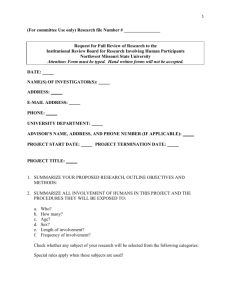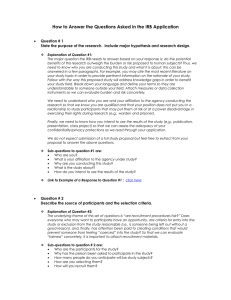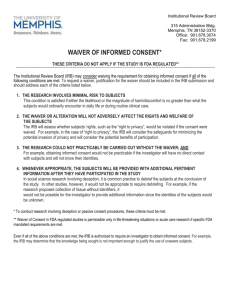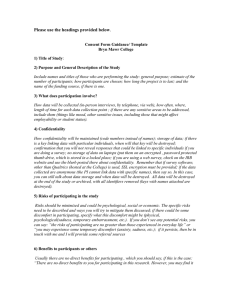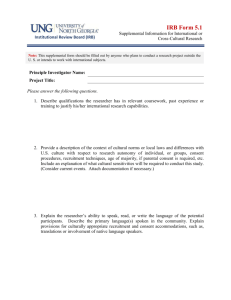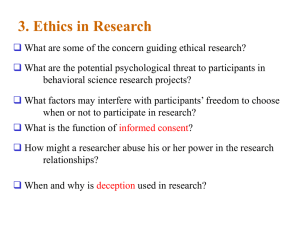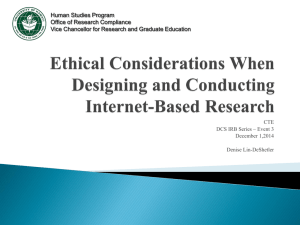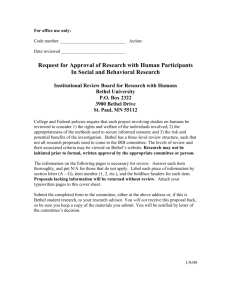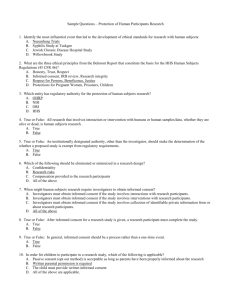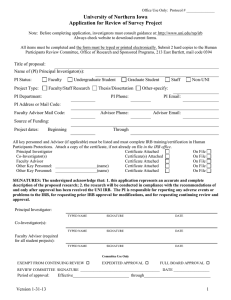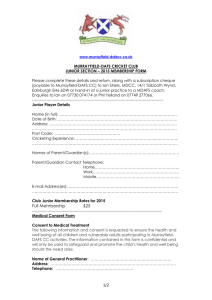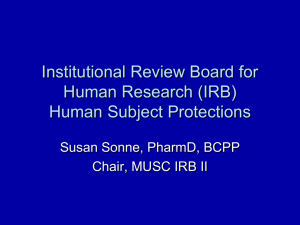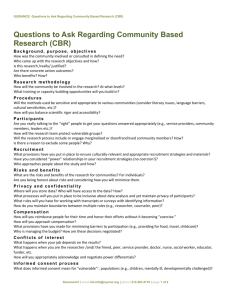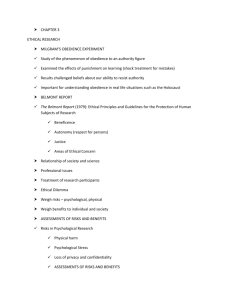RASCAL Study Description Help Text
advertisement
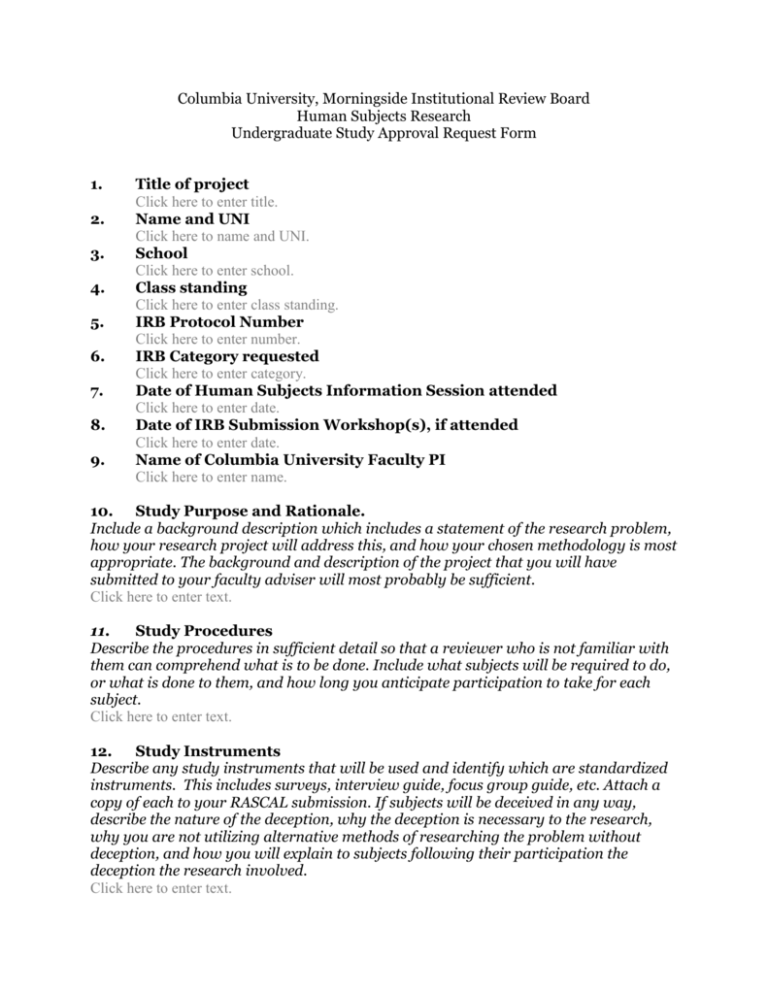
Columbia University, Morningside Institutional Review Board Human Subjects Research Undergraduate Study Approval Request Form 1. 2. 3. 4. 5. 6. 7. 8. 9. Title of project Click here to enter title. Name and UNI Click here to name and UNI. School Click here to enter school. Class standing Click here to enter class standing. IRB Protocol Number Click here to enter number. IRB Category requested Click here to enter category. Date of Human Subjects Information Session attended Click here to enter date. Date of IRB Submission Workshop(s), if attended Click here to enter date. Name of Columbia University Faculty PI Click here to enter name. 10. Study Purpose and Rationale. Include a background description which includes a statement of the research problem, how your research project will address this, and how your chosen methodology is most appropriate. The background and description of the project that you will have submitted to your faculty adviser will most probably be sufficient. Click here to enter text. 11. Study Procedures Describe the procedures in sufficient detail so that a reviewer who is not familiar with them can comprehend what is to be done. Include what subjects will be required to do, or what is done to them, and how long you anticipate participation to take for each subject. Click here to enter text. 12. Study Instruments Describe any study instruments that will be used and identify which are standardized instruments. This includes surveys, interview guide, focus group guide, etc. Attach a copy of each to your RASCAL submission. If subjects will be deceived in any way, describe the nature of the deception, why the deception is necessary to the research, why you are not utilizing alternative methods of researching the problem without deception, and how you will explain to subjects following their participation the deception the research involved. Click here to enter text. 13. Study Subjects. Identify how many research subjects you anticipate recruiting, including what criteria will be used to include or exclude individuals from your project. Make clear whether or not your project will include minors and other members of federally-identified vulnerable populations. Click here to enter text. 14. Recruitment Describe in detail how and where participants will be recruited including type (e.g., word of mouth, leaflets, letters, posters). Describe any payment or other inducements for participation that subjects will receive. Attach a copy of each written advertisement, letter, or poster, if any as well as verbal recruitment script. Click here to enter text. 15. Informed and Voluntary Consent Process Describe how consent will be obtained, including by whom, when, where, and by what method (e.g., use of consent form requiring signature, verbally in-person, verbally by telephone). Attach copies of all relevant informed consent forms. Click here to enter text. If relevant to your research, include the following: a) Describe means of communicating if non-English speaking, illiterate, or other vulnerable persons will be included among study subjects. Click here to enter text. b) Describe any visual aids or devices that may be used to help explain a complicated procedure or process. Click here to enter text. c) If subjects are deemed ‘vulnerable’, describe the steps you will take to minimize the risk of coercion or undue influence and how you will ensure subjects understand that participation is voluntary. Click here to enter text. d) If subjects are children, mentally infirm or otherwise not legally competent to consent, describe how their assent will be obtained and who consents on their behalf. Click here to enter text. Alternatively, explain why a consent waiver applies in this case. Click here to enter text. 16. Potential Risks Describe possible risks of harm (physical, psychological, legal, and/or social) to participants, specifically whether or not risk is greater than that which would be encountered in subjects’ daily life. Click here to enter text. If you anticipate there to be risks of harm to the participants, include the following: a) Describe why the risks are necessary Click here to enter text. b) Describe your plan for minimizing the risks Click here to enter text. c) Explain why alternative ways of conducting the research either do not reduce risk or do not address the research problem Click here to enter text. d) Where possible, include data on risks that have been encountered in past studies. If the occurrence of a certain adverse event was 20% or more, include those data in this description. Click here to enter text. e) Describe your plans in the event that a research subject is harmed. Click here to enter text. 17. Potential Benefits Provide a description of what benefits are expected, based on current knowledge. Identify direct benefits to individual study subjects and/or indirect benefits to this field of study. Click here to enter text. 18. Confidentiality of Study Data Describe how data will be recorded and stored (and for how long), specifically indicating whether data will contain direct or indirect identifiers. In addition, describe how data-security will be maintained (e.g. if the data is stored on a lap top that is stolen, how will the data be protected?). Click here to enter text. 19. Privacy Protections Describe how subjects’ expectations for privacy will be established, how their privacy will be protected, and what limits to protection will operate. For example, in the recruitment and data collection stages, how will you ensure that subjects can talk freely, discuss the research, and ask questions about participation without being heard and/or seen by others? Click here to enter text. 20. Non-CU Research Sites If you will be conducting research at another institution or organization (e.g. school, hospital, prison, corporation) describe how permission has been obtained and include letters of approval in your RASCAL submission. Click here to enter text. In addition, if you will be conducting research in another country you are required to submit a letter of approval from an expert in the locality and can attest to the appropriateness of your study design. This expert may be another member of the CU faculty or another qualified expert. Discuss with your faculty PI who can be asked to provide this statement. Click here to enter text.



